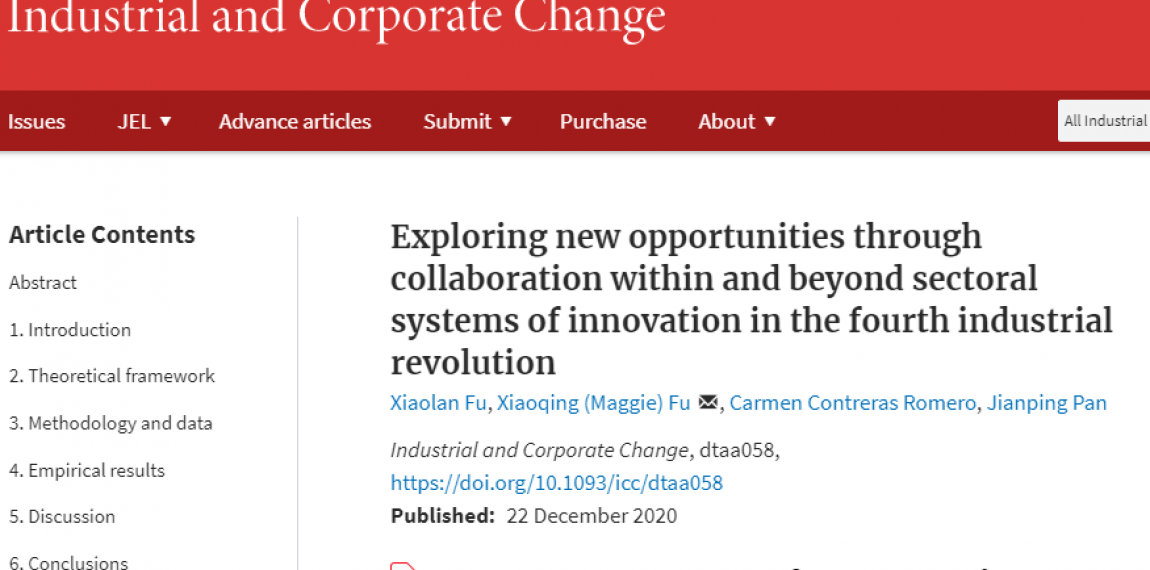
Published
TMCD Researchers publish new papers on innovation, inclusive growth, digital economy and the fourth industrial revolution
Researchers at TMCD have published new papers covering key issues in the areas of innovation, inclusive growth, digital economy and the fourth industrial revolution.
The first paper titled 'When do latecomer firms undertake international open innovation: Evidence from China' by Xiaolan Fu, Yawen Li, Jizhen Li and Henry Chesbrough is published in the Global Strategy Journal. This study examines how the characteristics of firms and their surrounding environment affect their engagement with international collaboration. Demand side factors appear to be more significant drivers of IOI in latecomer firms than the pursuit of technology leadership. Market expansion-oriented innovation strategy, international orientation, previous collaboration experiences, and technology intensity of the industry are found to be associated with a high degree of IOI; firms with stronger R&D capacity tend to be less open to international collaboration. Findings from this research are helpful for managers interested in using IOI to promote their companies' innovation performance, and to managers of MNEs or policy makers who would like to understand the international innovation strategy of Chinese firms.
The second paper titled 'Varieties in state capitalism and corporate innovation: Evidence from an emerging economy' by Yongjia Lin (Rebecca), Xiaoqing Fu (Maggie) and Xiaolan Fu. This study draws on data from 2629 listed firms in China between 2007 and 2015. Our results suggest that state-owned enterprises (SOEs) controlled by the central government show the strongest innovation performance in all scenarios. In addition, private firms outperform local SOEs in terms of patent quantity in both manufacturing and nonmanufacturing sectors and in high-economic-development regions, whereas local SOEs outperform their private peers with respect to patent quality, mainly in the manufacturing sector and high-economic-development regions. Such an ownership–innovation nexus is then found to be more pronounced for firms engaging in more ESG practices, during periods of higher EPU, and when less corruption is present. These findings demonstrate the value of diversity in state capitalism in guiding SOEs' heterogeneous innovation activities in emerging economies.
The third paper titled 'Diffusion of industrial robotics and inclusive growth: Labour market evidence from cross country data' by Xiaoqing (Maggie) Fu, Qun Bao, Hongjun Xie and Xiaolan Fu. This paper investigates the impact of industrial robot adoption on inclusive growth based on labour market evidence from a cross-country panel dataset of 74 economies between 2004 and 2016. It finds that the adoption of industrial robots is associated with significant gains in labour productivity and total employment in developed economies, while such effects are insignificant in developing countries. Increased robot adoption is related to a significantly lower labour share of GDP in developing economies but not in developed countries. Overall, in both developed and developing economies, increased robot adoption is linked with significantly higher income inequality, although there is no evidence of technological unemployment.
The fourth paper titled 'Exploring new opportunities through collaboration within and beyond sectoral systems of innovation in the fourth industrial revolution' by Xiaolan Fu, Xiaoqing (Maggie) Fu, Carmen Contreras Romero, Jianping Pan. This article investigates how a leading Chinese multinational enterprise in a core sector of the fourth industrial revolution manages research collaborations within and beyond its sectoral systems of innovation to create novel innovations and push the technological frontier of the industry. We find the firm expanded its technology boundaries through collaborations, particularly multidisciplinary collaborations in both core and noncore technological areas of the industry to establish and maintain its leadership in this dynamic sector. High disciplinary diversity in the company’s collaborative research portfolio is positively associated with the novelty of its innovation output.
The fifth and final paper titled 'Development strategies for middle-income countries in a digital world – insights from modern trade economics' by Jörg Mayer.This paper takes a trade economics perspective to outline a possible response to the changed nature of industrialization. The outlined response currently applies mainly to middle-income countries but deserves attention also in longer-term development strategies of low-income countries. The paper argues that digital technologies affect trade costs through various mechanisms, which apply differently to manufactures and services and determine decisions of multiproduct firms on what to produce for what market. Emphasizing big data analysis of customer preferences as an input to manufacturing, the paper finds that (i) industrialization and services-oriented development strategies are complements, rather than substitutes; (ii) access to data on customer preferences is an asset for developing countries; and (iii) data governance, which harnesses the increasing dependence of manufacturing on data, and innovation policies, which give greater importance to indigenous innovation, crucially augment the potential of industrialization as a development strategy in a digital era.


